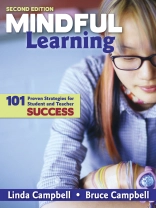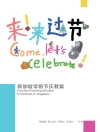‘For teachers who want to use more research-based strategies but have little time, this book is a gem. The simple format, great diagrams, additional reading sources, and research-supported strategies are all time-savers for busy educators.’
—Pattie Thomas, School Improvement Specialist
Talladega City Schools, AL
‘This book is a teacher′s toolbox, full of strategies that will strengthen student achievement. Once a teacher receives this resource, everyone in the school will want a copy!’
—Nancy Betler, Instructional Support Specialist
Charlotte-Mecklenburg Schools, NC
Discover 101 classroom-tested answers to the question, ‘How can I make my teaching more effective?’
Educators need a variety of easy-to-use tools to stimulate and engage students who process information with a variety of learning styles and who may have special learning needs. This second edition provides 101 research-based instructional strategies that teachers can immediately implement in the classroom to meet heightened accountability mandates and improve student achievement.
Each technique is compatible with brain-based teaching styles and has a proven track record with students of diverse ages, languages, abilities, and socioeconomic status. This revised edition features new strategies and graphics based on the latest research on improving learning, plus ready-to-use forms and checklists, updated resources, a greater emphasis on teaching students in special populations, and a reorganized structure that puts specific information at your fingertips. Readers will discover ways to:
- Use students′ prior knowledge
- Immerse students in active learning experiences and make content relevant
- Differentiate instruction for diverse learners, including English language learners and struggling students
- Provide gender-fair, equitable instruction
This indispensable manual will help you provide meaningful learning experiences to promote every student′s academic success!
Table des matières
Preface to the Second Edition
Acknowledgments
About the Authors
Introduction
1. Beginning With What Students Know: The Role of Prior Knowledge in Learning
What Role Does Background Knowledge Play in Learning?
What Do Research Studies Show About Prior Knowledge?
#1: The Known and the Unknown
#2: Things I Know, Think I Know, Want to Know
#3: What I Know, Want to Know, and Learned
#4: Getting Organized Graphically
#5: Visual Sequencing
#6: Visualizing Cause and Effect
#7: Seeing Similarities and Differences
#8: The Whole Pie
#9: Speaking Categorically
#10: Commonly Shared Prior Experiences
#11: Charting a Colorful Course
#12: Asking the Right Questions
#13: Guided Anticipation
#14: Thinking Out Loud
#15: Using Prior Knowledge Before, During, and After a Lesson
#16: It’s About the Words
#17: Word Diagramming
#18: Tracking Progress With Words
#19: Math Dilemmas
Suggestions for Further Information About Prior Knowledge
2. Active Learning: Differentiated Strategies for All Learners
What Do Research Studies Show About Active Learning?
Active Learning in the Classroom
#20: Give Me Five! An Active Learning Wheel for Teachers and Students
#21: A Collaborative and Active Learning Sequence
#22: A Day of Active Division
#23: Visually Introducing a Unit
#24: Structured Concepts
#25: Visual Report Writing
#26: Charting Skills: Estimation
#27: Visual Story Mapping
#28: Mass Media’s Messages
#29: Active Listening
#30: Active Reading
#31: Textbooks Are Friends!
#32: Active Involvement Through Discussion
#33: It’s Notable
#34: Thinking From A to V
#35: That’s Debatable
#36: Jigsaw Cards and Puzzles
#37: I’m Game
#38: Musical Learning
#39: Narrative Pantomime
#40: Role-Playing to Learn
#41: A Week’s Worth of Journaling
#42: Student Goal Setting
#43: Project-Based Learning
#44: Pulling It Together: Class Books
Suggestions for Further Information About Active Learning
3. Ensuring Gender-Fair Instruction
What Do Research Studies Show About Gender-Equitable Approaches to Improving Student Achievement?
#45: Conducting a Classroom Gender Audit
#46: Seeking Student Feedback on Gender Dynamics
#47: Assessing Bias in Curricular Materials
#48: Quality Questioning
#49: Using Inclusive Language
#50: Thinking While Listening
#51: Mix and Match
#52: Playing Games
#53: Sequence Cards
#54: Paper Plate Review
#55: Headbands
#56: A Word Tool Kit
#57: Bite-Size Reading
#58: Teaching Boys to Write
#59: Six Tips for Tech-Savvy Girls
#60: Creating a “Boy-Friendly” Classroom
#61: Exploring New Roles at School
#62: Peer Support Networks
#63: Orienting Eighth and Ninth Graders to High School
#64: Middle School Academic Preparation for High School Success
#65: Gender Equity Bookmark
Suggestions for Further Information About Gender Equity
4. Teaching Diverse Students: Addressing Language, Class, Culture, and Ability Differences in the Classroom
The Diversity of the U.S. Educational System
The Diversity of K-12 Students in the United States
Defining Racial Diversity
Defining the Concept of Students With Disabilities
Defining Students in Poverty
Defining Limited English Proficient Students
Implications of Student Diversity for the Classroom
Teaching Students With Special Needs in Mainstream Classrooms
Integrating Limited English Proficient Students Into Mainstream Classrooms
Teaching Racially Diverse Students
Teaching Students in Poverty
Reflecting on Teaching in Diverse Classrooms
#66: Tiered Instruction
#67: Tiered Spelling
#68: Do They Get It? Assessing Student Understanding in Inclusive Classrooms
#69: Teaching Elementary Readers
#70: Helping Struggling Intermediate Readers
#71: Teaching Reading in the Content Areas
#72: Helping Struggling Adolescent Readers
#73: Using Tutors to Increase Reading Achievement
#74: An Extra Net: Using Web Sites to Support the Needs of Diverse Learners
#75: Engaging the Gifted
#76: Helping New and Incoming Students
#77: Meeting the Needs of Preliterate English Language Learner Students
#78: Using English Effectively With English Language Learners
#79: Geometric Collaboration
#80: Collaborative Note Taking
#81: Teaching Standard English in the Multicultural Classroom
#82: High-Performing Teachers of High-Poverty Students
#83: Reducing Prejudice by Increasing Critical Thinking
#84: Multicultural Math
#85: Multicultural Literature
Suggestions for Further Information About Teaching Diverse Students
5. Assessing Student Performance
Defining Assessment Terms
What Does the Research Say About Using Assessment to Improve Teaching and Learning?
The Power of Performance Assessment
Using Performance Assessment in the Classroom
#86: It′s Not Business as Usual: Planning for Assessment
#87: Beginning With the End in Mind
#88: Taking Stock: Student Self-Assessment
#89: Collaborative-Assessment Conferences
#90: Test-Taking Matters
#91: Test-Taking Rules for Students
#92: Getting to Know You: Entry Interviews
#93: Saying Goodbye: Exit Interviews
#94: Taking Note With Anecdotal Records
#95: Making Rubrics
#96: Assessing Orally
#97: Observation Logs
#98: Checking Their Lists: Student Checklists
#99: Learning Logs
#100: Assessing Nontraditional Results
#101: Scheduling Assessment
Suggestions for Further Information About Assessing Student Performance
6. Some Concluding Thoughts
References
Index
A propos de l’auteur
Bruce Campbell has over 30 years of experience at all levels of education and has authored numerous articles and books. As a classroom teacher, he developed a nationally acclaimed elementary model that integrated direct instruction, learning centers, and student projects on a daily basis. Campbell currently teaches high-needs students in the Marysville School District, where he also coaches educators new to the profession. He is a frequent speaker at national conferences and has consulted for governmental and educational agencies in all 50 states. Additionally, Campbell has taught educators in countries around the world. His areas of focus are ways to improve instruction and how to spark a love of learning among students of all ages.












